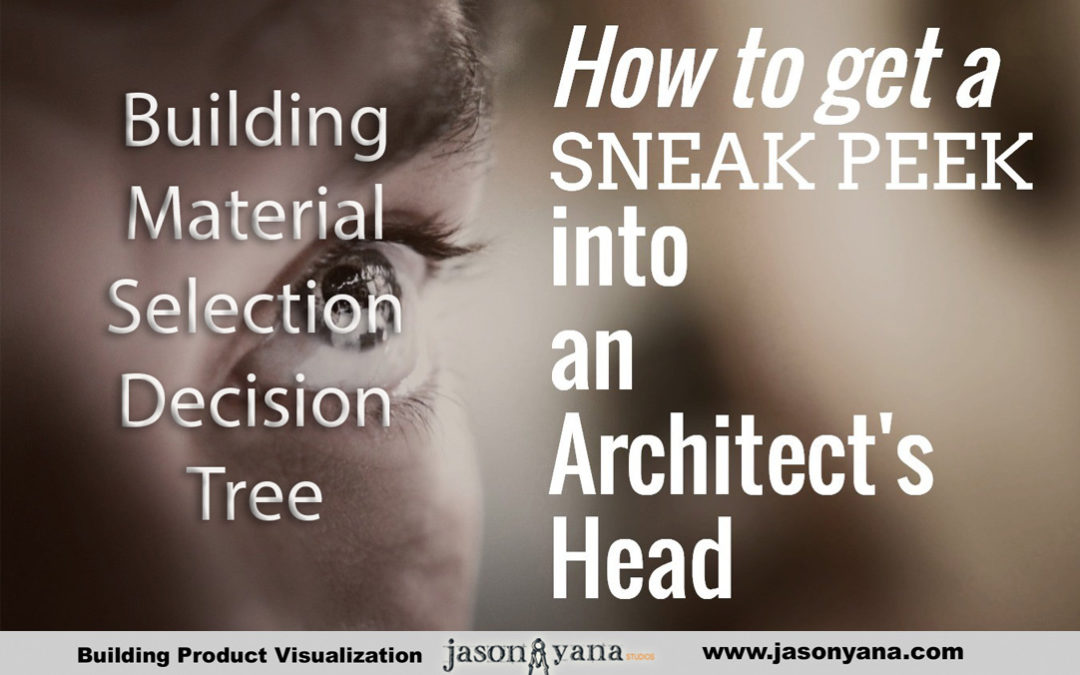The key to getting in front of the architect’s product decisions is to understand his process
Inside the architect’s mind… that’s a place you’d like to be to help fine-tune your building product marketing efforts. Am I right?
It’s like the copywriting legend, Robert Collier, once wrote, “a good ad begins with entering the conversation already taking place in your prospect’s mind.” That goes for all your marketing efforts and strategies.
So, that’s where I’m taking you today — inside the architect’s mind to see his decision-making process first hand.
Getting inside…
I recently heard they can study living animals through something called “intravital microscopy.” They attach a glass “window” to the animal and use a microscope to see how different internal systems work.
After I threw up in my mouth a little, I got to thinking, “Man, that would be nice if it could help see what some people are thinking…”
What’s that? You see where I’m going with this? Yes, that’s right. For you – my faithful reader – I tried my little heart out…
…But try as I might – with all my persuasiveness – I failed. I couldn’t find any architects who’d sit still long enough for me to attach this little looking glass I created to the top of their head.
Go figure.
So I found you the next best thing: An architect willing to share his thinking process as he searches for a new product. That’s what today’s post is about…
If you pay close attention, I think you’ll see a lot of great opportunities here. To get in front of some of these decision points and help you fine-tune your marketing to architects. I’ll be highlighting some of those key points along the way…
Discovering the need…
Alright, to set the stage for you a little, our architect friend here has a project that’s an addition to an existing building.
The existing building was built in the 1970s and has an exterior material – a fascia panel – that’s made of asbestos. So he needs to replace the material on the existing building and match it in the design of the new addition.
Let’s hear it straight from him on how he starts his search for the perfect product:

Thanks, Jason.
So, whenever I find myself at the beginning of my search for a new building product, I take stock of what factors are most important. In some cases, it’s part of a bigger picture and I need to consider all the adjacent materials around the product.
In this case, for simplicity, I’m able to focus on just this fascia panel material and walk you through my architectural decision tree. And then see how it progresses at each phase of the building project’s phases.
So the big question I need to start with is a common first question in most B2B buyers’ decision trees:
What’s important for my decision?
Here’s a list of the handful of points I was considering for this example product:
- Weight – The existing panels are about 4 feet wide and 3 feet tall. That means I look at materials that are lightweight, so the existing supporting structure can hold it.
- Durability – The building is out in the middle of a rural area, so it’ll see a lot of weather and wind. That means the panels need to be thick enough and perhaps a solid color (not painted), so they’ll stand up to the environment over time.
- Maintenance – The existing product requires little maintenance, so the replacement needs to have the same (or better) performance. In other words… no caulk joints to maintain… minimal painting required… easy replacement of a single panel…
- Cost – What costs are assumed in the preliminary estimates and the project budget? The proposed products need to be within the range, or close to what’s been assumed for the project.
- Design Options – Does the manufacturer provide a sufficient variety of standard colors, textures and standard sizes to choose from? Or will there be added costs to meet this project’s requirements?
Once I have my list of things I need to consider in my search, I start looking…
Jason’s Key Takeaway:
Always be looking for ways capture your prospect’s main concerns & criteria for selecting your product. Be sure to ask the question when you have the opportunity to talk with them about their project.
Make sure you write it down during, or right after your conversation and look at covering these items on your product website and in your marketing materials.

[convertkit]
Researching my options (Phase I) …
It wasn’t that long ago that my research would begin with opening a few volumes of Sweets catalogues. Or searching the shelves for a manufacturer’s product guide that might lead me to the right product.
But, as I’m sure you know, those days are pretty well gone. Our office still has a few product guides on the shelves. But those are mostly the ones that have other important information that we use during design. (…like a drywall manufacturer who provide guides to fire-rated wall assemblies…)
In today’s world, my search starts in one of three places:
• 4specs.com – or – Sweets.com
• Local suppliers’ and installers’ websites
On a product directory website like Sweets.com or 4specs.com, I go right to the division I think I’ll find the product I’m looking for. In this case, it’s Division 7 – Thermal and Moisture Protection. I drill down to the different siding panels and rain screen options to see what manufacturers are listed there.
Then I start poking around each of these manufacturer’s websites to see if there’s anything that fits the bill. If I see something promising, I’ll bookmark the page, or download some of the brochures or other readily available PDFs I come across.
Then I jump to the other options…
After this search, I’ll go to my trusted local suppliers’ websites to see if they carry any of these products. If they do, that product will start moving toward the top of my list. I’ll also search their website for any other products my initial search didn’t turn up.
Finally, I’ll hit a Google search. I’ll try a series of keywords that I think will turn up what I’m looking for. I’ll usually have some key phrase ideas in mind from the sites I’ve looked at so far. For this example, I’ve come up with “metal wall panels” and “fiber cement wall panels.” There might be a few others I use, depending on what these basic searches bring up.
Whatever terms I do use, I rarely go past the first page of search results to look for options.
Once I’ve got that initial short-list of options pared down, I’ll move on to the next step…
Jason’s Key Takeaways:
-
There was a key point about the types of product guides an architect still keeps on his shelves. Did you catch it? It’s the ones with additional helpful information inside.
-
If there’s anything helpful you can provide in your literature – calculators, rated assembly guides… anything – be sure to fold it into your product books. Then you’ll have a better chance of securing one of those coveted and increasingly rare places on the architect’s shelf.
-
-
Are you prominently listed in the different product directories out there? If not, you should be. And while you’re at it, make sure your company & product descriptions are well-written and make visitors want to click through to your site.
- Does your website have helpful information that’s easily located and downloaded? It’s the next best thing besides a physical leave-behind. If you’re just hoping the architect will find his way back to your website once he’s closed the tab you could be waiting a long time.

Initiating contact with a sales rep…
I start this next step by calling a rep or filling out a form on the manufacturer’s or local supplier’s website. It depends on what looks like the easiest way to get ahold of someone. If I have a good relationship with a product rep, I’ll usually have their contact information in my Outlook files.
If I can’t easily find any contact information on their website, I’ll just skip them, and go to the next supplier or product rep.
My goal here is to set up a call or a face-to-face meeting with the product rep to see the options. Or get supporting materials to help me in my continuing search and eventual next step of selling the idea to other project team members.
As we’re having our discussion, I’m looking at the following to decide if I continue down the path with this product rep:
Proper presentation of options – Are they able to show me all my viable options for my specific situation? If they just offer me the same generic information I can find on their website then I’m no better off.
I’m looking for photos of similar past projects. Illustrations or details of their product used in my specific application. And maybe a case study of a successful project that featured their product.
Open discussion about cost options – Do they discuss cost options and how their product might compare to other options? If not, I’m hesitant to take the chance that I’ll bust the budget with their product when the actual costs come in.
Do they install the product, or just supply? – This isn’t usually clear on a supplier’s website, but it’s important to be clear who installs the product. If it’s another sub-contractor, I want to know what kind of support the supplier or manufacturer provides during the installation.
Jason’s Key Takeaway:
When you get the chance for a face-to-face or phone call, this is where it’s critical to make sure you’ve got some great presentations or illustrations of your product
Brainstorm how you can meet the prospect’s questions with the answers he needs to make the right decision – your product. Keep your presentations fluid to incorporate new concerns or questions as you learn them from your discussions with architects.
Researching my options (Phase II) …
Once I’ve met with or spoken to the product reps, I move onto another level of research. This is digging in deeper with the more specific information I’ve received on their products.
What’s important here is that the supplier or product rep has left me with the following information:
- Case Studies – It’s important to know that other architects have used this product and speak highly of its benefits.
- Photos – I want to see images of the product in similar installations as the one I’m looking at.
- Building types – If the product provides certain benefits to my specific building type, it’s a definite plus.
- Detail conditions – Provide me with details that match my condition I’m looking at – a canopy fascia, an entrance portal, large wall surface… Whatever the case might be.
- Availability – I need to know if they have the colors & textures I’m looking for readily available. It would be even better if they have a good selection of photos in the finishes I need.
This second phase of research is where I’m preparing to select and sell the product I will recommend we use…
Jason’s Key Takeaway:
This one should be pretty obvious… Make sure creating these key pieces of content and getting them into the hands of your sales reps and suppliers.
If your product has a large selection of colors and textures, look to technology to help you represent those options as efficiently and attractively as possible.When you get the chance for a face-to-face or phone call, this is where it’s critical to make sure you’ve got some great presentations or illustrations of your product
Brainstorm how you can meet the prospect’s questions with the answers he needs to make the right decision – your product. Keep your presentations fluid to incorporate new concerns or questions as you learn them from your discussions with architects.
Whew – that’s a lot to take in. I hope you’re seeing the value of getting all of this valuable information straight from your prospect’s mouth.
I had to shut him down for now, or this post might have gone on forever. But don’t worry — I’m going to bring him back for another post. Part 2 of this series of posts, so stay tuned.
Coming up next in part two . . .
-
How the architect sells your product to his project team…
-
What you can do to make the architect’s job easier during the construction document phase…
-
How you can arm the architect to defend your product from substitutions…
-
What you need to be doing to follow-up and remind the architect of the benefits you provided…
-
…And finally, how your product can become part of the architect’s “best practices” for future projects.
About the Author :
Jason Yana has 2 decades of experience in architectural technology, 3d graphics and construction marketing. This unique combination provides highly-effective visual representations of building products that fuel marketing and support efforts.
His award-winning body of work informs, inspires and educates building product customers.
Final Note:
If you’d like to read a little more about this topic of getting inside an architect’s head, take a look at this post on Venveo’s blog.
It’s an article written for you by our architect friend who’s sharing this look behind the curtain…
Venveo, in case you didn’t know them, are experts in building websites for building material manufacturers.

